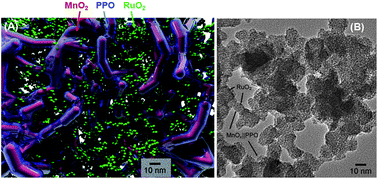Nanoscale Hot Article: just published

In these structures, the three critical components of a battery (cathode, separator/electrolyte, and anode) are assembled internally as tri-continuous nanoscopic phases in three steps: First, the formation of a monolithic manganese oxide ambigel nanoarchitecture. Second, the electrodeposition of a conformal ultrathin polymer (separator/electrolyte). And third, the infiltration of a counter insertion electrode (RuO2) within the residual interconnected free volume.
Using Transmission Electron Microscopy, Jeffrey Long and Debra Rolison (US Naval Research Laboratory) and their colleagues have characterized the architectures that contain all three components for a solid-state energy storage device within a void volume of tens of nanometres and have nanometre-thick distances between the opposing electrodes.
Read the article now
Architectural integration of the components necessary for electrical energy storage on the nanoscale and in 3D
Christopher P. Rhodes, Jeffrey W. Long, Katherine A. Pettigrew, Rhonda M. Stroud and Debra R. Rolison
Nanoscale, 2011, DOI: 10.1039/C0NR00731E










